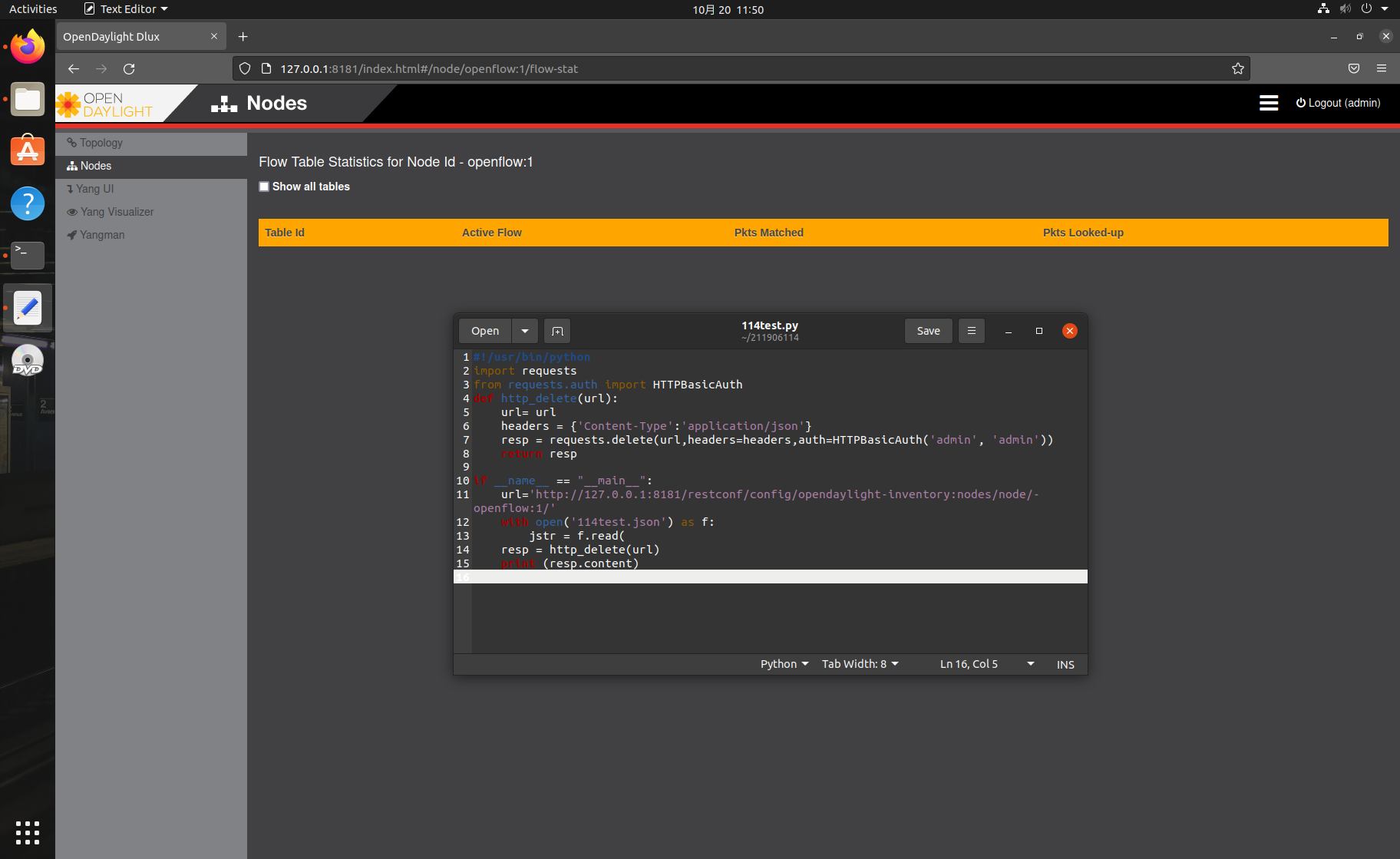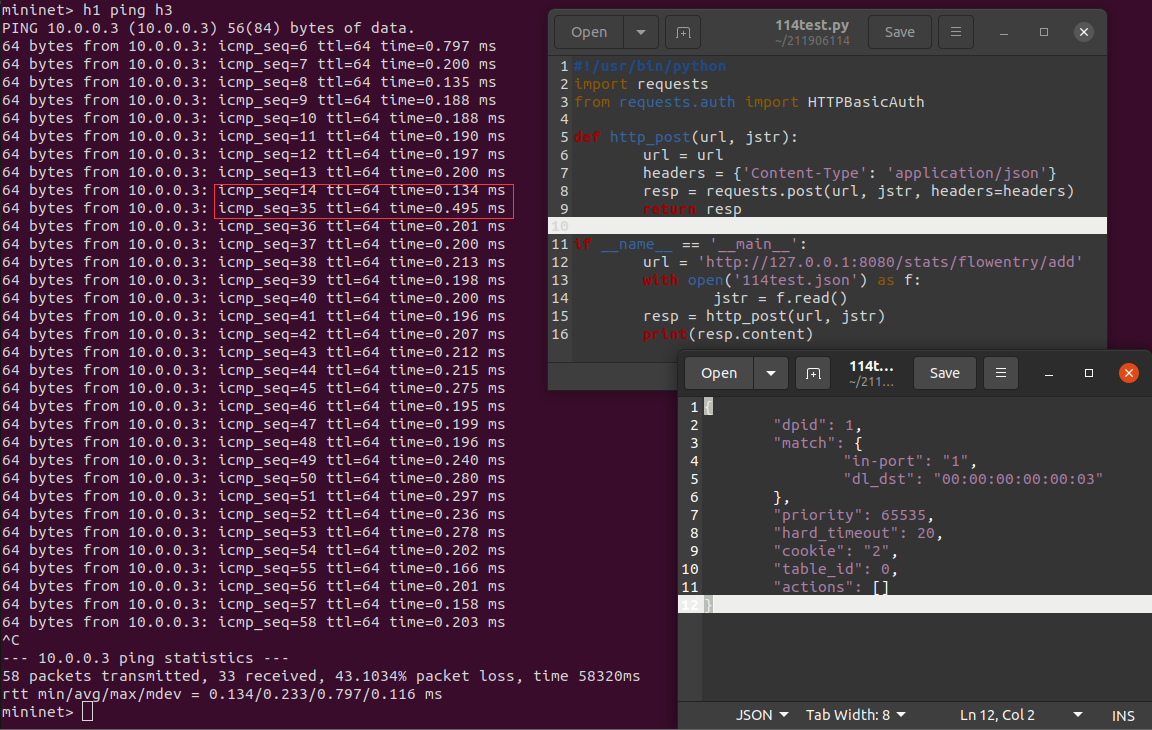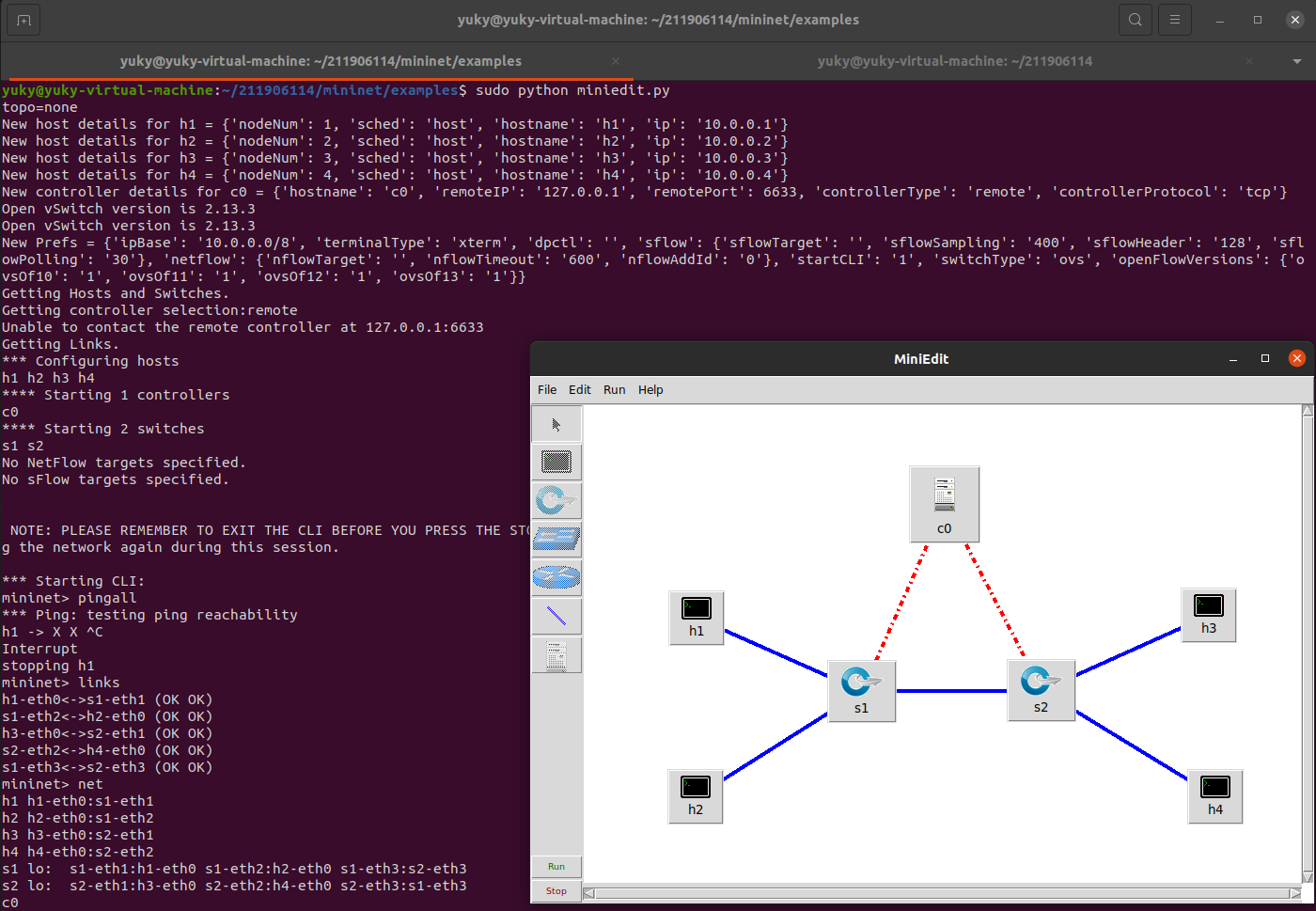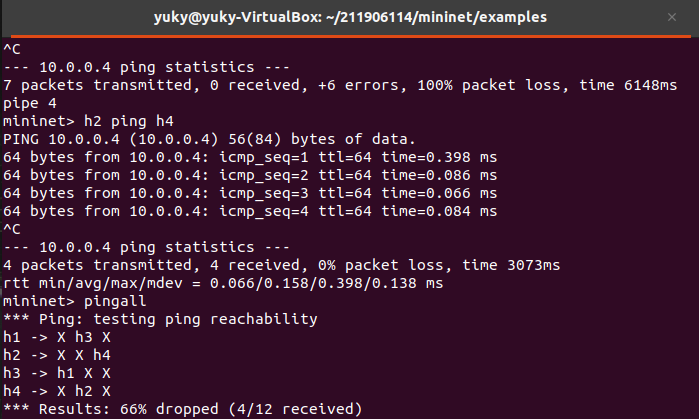实验7:基于REST API的SDN北向应用实践
一、OpenDaylight
1.利用Mininet平台搭建下图所示网络拓扑,并连接OpenDaylight;
-
搭建拓扑:sudo mn --topo=single,3 --mac --controller=remote,ip=127.0.0.1,port=6633 --switch ovsk,protocols=OpenFlow10
-
连接OpenDaylight(ODL目录下):./distribution-karaf-0.6.4-Carbon/bin/karaf
2.编写Python程序,调用OpenDaylight的北向接口下发指令删除s1上的流表数据。
import requests
from requests.auth import HTTPBasicAuth
def http_delete(url):
url= url
headers = {'Content-Type':'application/json'}
resp = requests.delete(url,headers=headers,auth=HTTPBasicAuth('admin', 'admin'))
return resp
if __name__ == "__main__":
url='http://127.0.0.1:8181/restconf/config/opendaylight-inventory:nodes/node/openflow:1/'
with open('114test.json') as f:
jstr = f.read(
resp = http_delete(url)
print (resp.content)

3.编写Python程序,调用OpenDaylight的北向接口下发硬超时流表,实现拓扑内主机h1和h3网络中断20s。
import requests
from requests.auth import HTTPBasicAuth
def http_put(url,jstr):
url= url
headers = {'Content-Type':'application/json'}
resp = requests.put(url,jstr,headers=headers,auth=HTTPBasicAuth('admin', 'admin'))
return resp
if __name__ == "__main__":
url='http://127.0.0.1:8181/restconf/config/opendaylight-inventory:nodes/node/openflow:1/flow-node-inventory:table/0/flow/1'
with open('114test.json') as f:
jstr = f.read()
resp = http_put(url,jstr)
print (resp.content)

4.编写Python程序,调用OpenDaylight的北向接口获取s1上活动的流表数。
import requests
import json
from requests.auth import HTTPBasicAuth
def http_get(url):
url= url
headers = {'Content-Type':'application/json'}
resp = requests.get(url,headers=headers,auth=HTTPBasicAuth('admin','admin'))
return resp
if __name__ == "__main__":
url = 'http://127.0.0.1:8181/restconf/operational/opendaylight-inventory:nodes/node/openflow:1/flow-node-inventory:table/0/opendaylight-flow-table-statistics:flow-table-statistics'
with open('114test.json') as f:
jstr = f.read()
resp = http_get(url)
print(resp.content)

二、Ryu
1.编写Python程序,调用Ryu的北向接口,实现上述OpenDaylight实验拓扑上相同的硬超时流表下发
import requests
from requests.auth import HTTPBasicAuth
def http_post(url,jstr):
url= url
headers = {'Content-Type':'application/json'}
resp = requests.post(url,jstr,headers=headers)
return resp
if __name__ == "__main__":
url='http://127.0.0.1:8080/stats/flowentry/add'
with open('114test.json') as f:
jstr = f.read()
resp = http_post(url,jstr)
print (resp.content)
{
"dpid": 1,
"match": {
"in-port": "1",
"dl_dst": "00:00:00:00:00:03"
},
"priority": 65535,
"hard_timeout": 20,
"cookie": "2",
"table_id": 0,
"actions": []
}

2.利用Mininet平台搭建下图所示网络拓扑,要求支持OpenFlow 1.3协议,主机名、交换机名以及端口对应正确。拓扑
生成后需连接Ryu,且Ryu应能够提供REST API服务。
- 连接Ryu:ryu-manager ryu/ryu/app/gui_topology/gui_topology.py --observe-links


3.整理一个Shell脚本,参考Ryu REST API的文档,利用curl命令,实现和实验2相同的VLAN。
curl -X POST -d '{
"dpid": 1,
"match": {
"in_port": 1
},
"actions": [
{
"type": "PUSH_VLAN",
"ethertype": 33024
},
{
"type": "SET_FIELD",
"field": "vlan_vid",
"value": 4096
},
{
"type":"OUTPUT",
"port": 3
}
],
"priority":5
}' http://localhost:8080/stats/flowentry/add
curl -X POST -d '
{
"dpid": 1,
"priority":5,
"match": {
"in_port": 2
},
"actions": [
{
"type": "PUSH_VLAN",
"ethertype": 33024
},
{
"type": "SET_FIELD",
"field": "vlan_vid",
"value": 4097
},
{
"type":"OUTPUT",
"port": 3
}
]
}' http://localhost:8080/stats/flowentry/add
curl -X POST -d '
{
"dpid": 1,
"match": {
"vlan_vid": 0
},
"actions": [
{
"type": "POP_VLAN",
"ethertype": 33024
},
{
"type":"OUTPUT",
"port": 1
}
],
"priority":5
}
' http://localhost:8080/stats/flowentry/add
curl -X POST -d'
{
"dpid": 1,
"match": {
"vlan_vid": 1
},
"actions": [
{
"type": "POP_VLAN",
"ethertype": 33024
},
{
"type":"OUTPUT",
"port": 2
}
],
"priority":5
}
' http://localhost:8080/stats/flowentry/add
curl -X POST -d '{
"dpid": 2,
"match": {
"in_port": 1
},
"actions": [
{
"type": "PUSH_VLAN",
"ethertype": 33024
},
{
"type": "SET_FIELD",
"field": "vlan_vid",
"value": 4096
},
{
"type":"OUTPUT",
"port": 3
}
],
"priority":5
}' http://localhost:8080/stats/flowentry/add
curl -X POST -d '
{
"dpid": 2,
"match": {
"in_port": 2
},
"actions": [
{
"type": "PUSH_VLAN",
"ethertype": 33024
},
{
"type": "SET_FIELD",
"field": "vlan_vid",
"value": 4097
},
{
"type":"OUTPUT",
"port": 3
}
],
"priority":5
}' http://localhost:8080/stats/flowentry/add
curl -X POST -d '
{
"dpid": 2,
"match": {
"vlan_vid": 0
},
"actions": [
{
"type": "POP_VLAN",
"ethertype": 33024
},
{
"type":"OUTPUT",
"port": 1
}
],
"priority":5
}
' http://localhost:8080/stats/flowentry/add
curl -X POST -d'
{
"dpid": 2,
"match": {
"vlan_vid": 1
},
"actions": [
{
"type": "POP_VLAN",
"ethertype": 33024
},
{
"type":"OUTPUT",
"port": 2
}
],
"priority":5
}' http://localhost:8080/stats/flowentry/add

进阶要求
- 编程实现基本要求第2部分Ryu(3)中的VLAN划分。
#!/usr/bin/python
import requests
from requests.auth import HTTPBasicAuth
def http_post(url, js):
url = url
headers = {'Content-Type': 'application/json'}
resp = requests.post(url, jstr, headers=headers)
return resp
if __name__ == '__main__':
url = 'http://localhost:8080/stats/flowentry/add'
for i in range(1, 9):
with open('%s.json' % i) as f:
jstr = f.read()
resp = http_post(url, jstr)
print(resp.content)
实验总结
个人总结与想法
实验难度略高,开始没理解题目,看了之前自己的博客思考了很久才醒悟。后主要时间耗费在修改python代码上,各种报错差点就放弃了。首先是({"errors":{"error":[{"error-type":"protocol","error-tag":"unknown-element","error-message":""flownode-inventory" module does not exist."}]}} 和 IndentationError: expected an indented block)!!!其实只要第一个会了,后面的基本操作上没太大区别。进阶懒了,进行一个拙略的模仿了。
困难与解决方法
1.ImportError: No module named requests,可能不小心删了文件夹,按安装指导的解决办法就没报错了
2.代码缩进和连接符,还是要养成写代码格式规范的好习惯
3.有时候会突然连接不上控制器或者已经没问题还一直报错,再一次觉得重启能解决99%的问题,1%建议直接重装系统
PS:不清楚怎么开始可以看看



